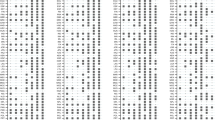Abstract
This paper presents a theoretical growth model that extends the Mankiw–Romer–Weil (MRW) model by accounting for technological interdependence among regional economies. Interdependence is assumed to work through spatial externalities caused by disembodied knowledge diffusion. The transition from theory to econometrics leads to a reduced-form empirical spatial Durbin model specification that explains the variation in regional levels of per worker output at steady state. A system of 198 regions across 22 European countries over the period from 1995 to 2004 is used to empirically test the model. Testing is performed by assessing the importance of cross-region technological interdependence and measuring direct and indirect (spillover) effects of the MRW determinants on regional output.
Similar content being viewed by others
References
Anselin L (1988) Spatial econometrics: methods and models. Kluwer, Dordrecht
Anselin L, Bera AK (1998) Spatial dependence in linear regression models with an introduction to spatial econometrics. In: Ullah A, Giles D (eds) Handbook of applied economic statistics. Marcel Dekker, New York, pp 237–289
Benhabib J, Spiegel MM (1994) The role of human capital in economic development. Evidence from aggregate cross-country data. J Monet Econ 34(2): 143–173
Cliff A, Ord JK (1981) Spatial processes: models and applications. Pion, London
Davidson R, MacKinnon J (1993) Estimation and inference in econometrics. Oxford University Press, New York
Durlauf S (2001) Manifesto for a growth econometrics. J Econom 100(1): 65–69
Durlauf SN, Johnson PA (1995) Multiple regimes and cross-country growth behaviour. J Appl Econom 10(4): 365–384
Durlauf SN, Quah DT (1999) The new empirics of economic growth. In: Taylor JB, Woodford M (eds) Handbook of macroeconomics, vol 1. Elsevier, Amsterdam, pp 235–308
Ertur C, Koch W (2006) Convergence, human capital and international spillovers. Working paper, LEG 2006-03. Université de Bourgogne, France
Ertur C, Koch W (2007) Growth, technological interdependence and spatial externalities: theory and evidence. J Appl Econom 22(6): 1033–1062
Ertur C, Koch W (2008) The role of human capital and technological interdependence in growth and convergence processes: international evidence. Working paper, LEG 2008-12. Université de Bourgogne, France
Fingleton B (2001) Equilibrium and economic growth: spatial econometric models and simulations. J Reg Sci 41(1): 117–147
Fingleton B, Fischer MM (2009) Neoclassical theory versus new economic geography: competing explanations of cross-regional variation in economic development. Ann Reg Sci 43. doi:10.1007/s00168-008-0278-z
Fischer MM, Stirböck C (2006) Pan-European regional income growth and club-convergence. Ann Reg Sci 40(4): 693–721
Fischer MM, Varga A (2003) Spatial knowledge spillovers and university research. Ann Reg Sci 37(2): 303–322
Fischer MM, Scherngell T, Jansenberger E (2006) The geography of knowledge spillovers between high-technology firms in Europe. Geogr Anal 38(3): 288–309
Fischer MM, Scherngell T, Reismann M (2009) Knowledge spillovers and total factor productivity. Evidence using a spatial panel data model. Geogr Anal 41(2): 204–220
Getis A (2005) Spatial pattern analysis. In: Kempp-Leonard K (eds) Encyclopedia of social measurement. Academic Press, Amsterdam, pp 627–632
Griffith DA (1995) Some guidelines for specifying the geographic weights matrix contained in spatial statistics models. In: Arlinghaus SL, Griffith DA, Arlinghaus WC, Drake WD, Nystrom JD (eds) Practical handbook of spatial analysis. CRC Press, Boca Raton, pp 65–82
Griliches Z (2000) R&D, education, and productivity. A retrospective. Harvard University Press, Cambridge
Grossman GM, Helpman E (1991) Innovation and growth in the global economy. MIT Press, Cambridge
Hall RE, Jones C (1999) Why do some countries produce so much more output per worker than others. Q J Econ 114(1): 83–116
Islam N (1995) Growth empirics: a panel data approach. Q J Econ 110(4): 1127–1170
Keller W (2002) Geographic localization of international technology diffusion. Am Econ Rev 92(1): 120–142
LeSage JP, Fischer MM (2008) Spatial growth regressions: model specification, estimation and interpretation. Spatial Econ Anal 3(3): 275–304
LeSage JP, Pace RK (2009) Introduction to spatial econometrics. CRC Press, Boca Raton
LeSage JP, Pace RK (2010) Spatial econometric models. In: Fischer MM, Getis A (eds) Handbook of applied spatial data analysis. Springer, Berlin, pp 359–380
Levine R, Renelt D (1992) A sensitivity analysis of cross-country growth regressions. Am Econ Rev 82(4): 942–963
López-Bazo E, Fingleton B (2006) Empirical growth models with spatial effects. Papers Reg Sci 85(2): 177–198
López-Bazo E, Vayá E, Artís M (2004) Regional externalities and growth: evidence from European regions. J Reg Sci 44(1): 43–73
Mankiw NE, Romer D, Weil DN (1992) A contribution to the empirics of economic growth. Q J Econ 107(2): 407–437
Ord JK (1975) Estimation methods for models of spatial interaction. J Am Stat Assoc 70(349): 120–126
Pritchett L (2001) Where has all the education gone. World Bank Econ Rev 15(3): 367–391
Romer PM (1986) Increasing returns and long run growth. J Political Econ 94(5): 1002–1037
Stiroh KJ (2003) Growth and innovation in the new economy. In: Jones DC (eds) New economy handbook. Academic Press, Amsterdam, pp 723–751
Temple JRW (1998) Robustness tests of the augmented Solow model. J Appl Econom 13(4): 361–375




